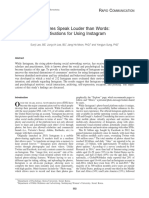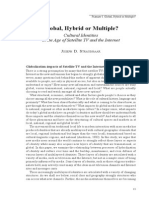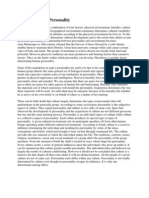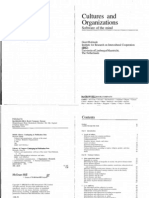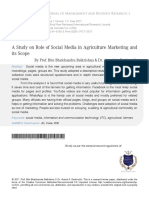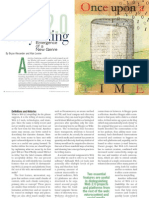Social Media As Participatory Culture: Key Questions
Social Media As Participatory Culture: Key Questions
Uploaded by
Enes PraskoCopyright:
Available Formats
Social Media As Participatory Culture: Key Questions
Social Media As Participatory Culture: Key Questions
Uploaded by
Enes PraskoOriginal Title
Copyright
Available Formats
Share this document
Did you find this document useful?
Is this content inappropriate?
Copyright:
Available Formats
Social Media As Participatory Culture: Key Questions
Social Media As Participatory Culture: Key Questions
Uploaded by
Enes PraskoCopyright:
Available Formats
Social Media as
Participatory Culture
Key questions
•• What is participatory culture? How have different scholars attempted to
define it?
•• How have scholars understood participatory culture within the realm of
socialmedia?
•• What do scholars mean by ‘participatory democracy’?
•• Are contemporary social media truly participatory?
Key concepts
Henry Jenkins’s notions of Participatory culture as ideology
participatory culture and Participatory democracy
spreadable media Digital labour
Overview
Participatory culture is a term that is often used for designating the involvement
of users, audiences, consumers and fans in the creation of culture and content.
Examples are the joint editing of an article on Wikipedia, the uploading of images
to Flickr or Facebook, the uploading of videos to YouTube and the creation of
short messages on Twitter or Weibo.
The participatory culture model is often opposed to the mass media and
broadcasting model typical of newspapers, radio and television, where there is
one sender and many recipients. Some scholars argue that culture and society
become more democratic because users and audiences are enabled to produce
03_Fuchs_Ch-03.indd 52 11/15/2013 5:30:28 PM
Social Media as Participatory Culture 53
culture themselves and to not just listen or watch without actively making and
creating culture:
•• The Internet analyst Clay Shirky (2011a, 27) has argued that social media
result in “the wiring of humanity” and let “us treat free time as a shared
global resource, and lets us design new kinds of participation and sharing
that take advantage of that resource”.
•• The Australian scholar Axel Bruns argues that produsage, the combina-
tion of production and use, is characteristic of social media. As the result
of social media he envisions a “produsage-based, participatory culture”
(Bruns 2008, 256) and “a produsage-based democratic model” (372).
•• Similarly, the business consultants Don Tapscott and Anthony Williams
(2007, 15) argue that social media result in the emergence of “a new eco-
nomic democracy […] in which we all have a lead role”.
All three statements have in common that they highlight positive aspects of social
media and point out that these media are possible to make culture and society
more democratic. This chapter critically questions these claims. Section 3.1 dis-
cusses the notion of participatory culture, section 3.2 deals with Henry Jenkins’
focus on fan culture, section 3.3 addresses his discussion of social media, and
section 3.4 looks at how he sees the so-called digital labour debate, i.e. the role of
unpaid user activities in value-generation.
3.1. The Notions of Participation and
Participatory Culture
Social Media as Spreadable Media
For Henry Jenkins, the main characteristic of “social media”/“web 2.0” is that
they are spreadable media (Jenkins, Li, Krauskopf and Green 2009): “Consumers
play an active role in ‘spreading’ content [. . .] Consumers in this model are [. . .]
grassroots advocates for materials which are personally and socially meaningful
to them” (Jenkins et al. 2009, part 2). Spreadable media are based on the logic “if
it doesn’t spread, it’s dead” (Jenkins, Ford and Green 2013, 1) and involve audi-
ences that “actively” shape “media flows” (2) so that culture becomes “far more
participatory” (1). Sharing, co-creation, remixing, reuse and adaption of content
on Facebook, YouTube and other online platforms are, for Jenkins, a manifestation
of a gift economy.
He argues that spreadable media “empower” consumers and “make them an
integral part” of a commodity’s success (Jenkins et al. 2009, part 8). The “longer
term” benefits would include the expansion of “the range of potential markets
for a brand” and the intensification of “consumer loyalty by increasing emotional
attachment to the brand or media franchise” (Jenkins et al. 2009, part 8).
03_Fuchs_Ch-03.indd 53 11/15/2013 5:30:28 PM
54 Social Media: A Critical Introduction
Jenkins, Ford and Green (2013, xii) argue that they “accept as a starting point
that the constructs of capitalism will greatly shape the creation and circulation
of most media texts for the foreseeable future” and that those companies that
“listen to [. . .] their audiences” will strive. They accept the logic of capitalism
in a time of crisis, where trust in corporations is low and capitalism has shown
that it organizes society necessarily in such a way that exploitation, misery and
precariousness are a necessary reality for a certain share of people.
When Pepsi launched a marketing campaign in 2007, which allowed consum-
ers to design the look of a Pepsi can that was featured on 500 million Pepsi cans
around the United States, the task was not, as frequently claimed by manage-
ment gurus, to create “a new economic democracy [. . .] in which we all have a
lead role” (Tapscott and Williams 2007, 15; for a critique of this approach, see
Fuchs 2008b), but to outsource design work and thereby surplus value-gener-
ation cheaply to consumers and to ideologically bind the emotions of the con-
sumers to the brand so that more Pepsi could be sold and more profit be made.
The Convergence Culture Consortium that includes GSD&M Advertising, MTV
Networking and Turner Broadcasting funded Jenkins’ study of spreadable media.
Participatory Culture
For Jenkins, social media are also an expression of participatory culture. Jenkins
defines participatory culture as culture “in which fans and other consumers are
invited to actively participate in the creation and circulation of new content”
(Jenkins 2008, 331). It also involves “participants who interact with each other”
(Jenkins 2008, 3). Participation involves, for Jenkins, “new forms of participa-
tion and collaboration” (Jenkins 2008, 256). Jenkins points out, based on Pierre
Lévy (1997), that those who engage in “participatory culture” pool resources and
combine skills so that collective intelligence emerges as “an alternative source of
media power” (Jenkins 2008, 4).
Jenkins defines participatory as a culture with:
1. relatively low barriers to artistic expression and civic engagement,
2. strong support for creating and sharing creations with others,
3. some type of informal mentorship whereby what is known by the
most experienced is passed along to novices,
4. members who believe that their contributions matter, and
5. members who feel some degree of social connection with one another
(at the least, they care what other people think about what they have
created). (Jenkins, Purushotma, Weigel, Clinton and Robison 2009, 5f)
Participatory Democracy
Jenkins has argued that increasingly “the Web has become a site of consumer
participation” (Jenkins 2008, 137). A problem of concepts like “participatory cul-
ture” is that participation is a political science term that is strongly connected to
03_Fuchs_Ch-03.indd 54 11/15/2013 5:30:28 PM
Social Media as Participatory Culture 55
participatory democracy theory and authors like Crawford Macpherson (1973)
and Carole Pateman (1970). An article by Staughton Lynd (1965) that describes
the grassroots organization model of the Students for a Democratic Society (SDS)
made the earliest use of the term “participatory democracy” that I could trace in
the literature. One should avoid a vulgar use of the term “participation”. Internet
Studies should relate the usage of the term to participatory democracy theory, in
which it has the following dimensions (Fuchs 2011b, chapter 7):
1. The intensification and extension of democracy as grassroots democracy to
all realms of society.
2. The maximization of human capacities (Macpherson (1973): human devel-
opmental powers) so that humans become well-rounded individuals.
3. Extractive power as impediment for participatory democracy:
Macpherson (1973) argues that capitalism is based on an exploitation
of human powers that limits the development of human capacities. The
modern economy “by its very nature compels a continual net trans-
fer of part of the power of some men to others [for the benefit and the
enjoyment of the others], thus diminishing rather than maximizing the
equal individual freedom to use and develop one’s natural capacities”.
(Macpherson 1973, 10f)
4. Participatory decision-making.
5. Participatory economy: a participatory economy requires a “change in
the terms of access to capital in the direction of more nearly equal access”
(Macpherson 1973, 71) and “a change to more nearly equal access to
the means of labour” (73). In a participatory society, extractive power is
reduced to zero (74). A democratic economy involves “the democratising
of industrial authority structures, abolishing the permanent distinction
between ‘managers’ and ‘men’” (Pateman 1970, 43).
6. Technological productivity as material foundation of participatory democracy.
7. Participation as education in participation.
8. Pseudo-participation as ideology.
Ignoring Ownership, Capitalism and Class:
Cultural and Political Reductionism
For Jenkins, participation means that humans meet on the net, form collec-
tives, create and share content. He has a culturalistic understanding of partici-
pation and ignores the notion of participatory democracy, a term which has
political, political economic and cultural dimensions. Jenkins’ definition and
use of the term “participatory culture” ignores aspects of participatory democ-
racy; it ignores questions about the ownership of platforms/companies, col-
lective decision-making, profit, class and the distribution of material benefits.
Jenkins, Purushotma, Weigel, Clinton and Robison (2009, 9) mention community
03_Fuchs_Ch-03.indd 55 11/15/2013 5:30:28 PM
56 Social Media: A Critical Introduction
membership, production, collaboration and sharing as activities in participatory
cultures, whereas ownership is not mentioned. The 11 skills listed as charac-
teristics for literacy in participatory culture do not include critical thinking, but
rather activities that can all work well in a company context (collective intel-
ligence, networking, multitasking, etc.; Jenkins, Purushotma, Weigel, Clinton and
Robison 2009, xiv). Corporate platforms owned by Facebook, Google and other
large companies strongly mediate the cultural expressions of Internet users.
Neither the users nor the waged employees of Facebook, Google and others
determine the business decisions of these companies. They do not “participate”
in economic decision-making, but are excluded from it.
Jenkins’ concept of participation is not theoretically grounded. Also, Nico
Carpentier (2011), who advances a more nuanced approach that is grounded
in political theory, ignores ownership aspects of the participation concept. He
conceives participation as “equal power relations in decision-making processes”
(Carpentier 2011, 69) and media participation as co-decision-making in the con-
texts of media technology, content, people and organizations (130). This notion
of media participation is explicitly a political concept (354), focusing on involve-
ment in media decision-making (355) and avoiding a broad definition of par-
ticipation (69). Carpentier does not include aspects of media ownership, neither
does he consider ownership questions as questions relating to participation. In
contrast to Crawford MacPherson, Carpentier ignores the level of political econ-
omy of participation and reduces participation to the political level. The problem
of Carpentier’s political reductionistic concept of (media) participation is that it
implies that full “participation” can be achieved without letting people partici-
pate in the ownership of the organizations in which they work, as long as they
are involved in decision-making. The topic of inequality of ownership and wealth
is ignored and declared to be secondary or unimportant. A truly participatory
media democracy must also be an ownership democracy (Fuchs 2014, 2011b).
Carpentier, although being theoretically versed and well read, just like Jenkins,
ends up with a reductionistic concept of media participation. Reductionism
means that a certain aspect of the world is explained based on one specific
dimension, although other dimensions also matter. In the social sciences, liberal
and conservative scholars have often claimed that Marxism reduces explana-
tions of society to the economy. At the same time, the same scholars often ignore
aspects of class and capitalism and thereby reduce explanations of society either to
politics (politicism, political reductionism) or culture (culturalism).
Jenkins, Ford and Green (2013, 193) argue that participatory culture is rela-
tive and that we “do not and may never live in a society where every member
is able to fully participate”. This passage essentializes exclusion, as if it were a
natural feature of every type of society. Essentialism is a form of argumentation
that does not see phenomena as historical, which means that they have a begin-
ning and an end and can be changed by human action. These phenomena (such
as money, capital, domination, violence, egoism, competition, etc.) are declared
to exist necessarily and forever. Karl Marx (1867) has termed this form of argu-
mentation “fetish thinking”: certain phenomena are treated like being things
03_Fuchs_Ch-03.indd 56 11/15/2013 5:30:28 PM
Social Media as Participatory Culture 57
and the fact that they are social circumstances that can be changed by humans
is ignored.
Participation means that humans have the right and reality to be part of deci-
sions and to govern and control the structures that affect them. Rights are always
universal and not particularistic. For example, if human rights are only valid for
some people but not others, then they are no rights at all. Similarly, participation
is a universal political demand, not a relative category. Otherwise one could say
that a dictatorship is a participatory democracy because a ruling elite is “partici-
pating”, which is, however, only a relatively small part of the population.
When Jenkins writes about political goals, he remains rather vague with for-
mulations such as the demand for “corporate responsibility” (Jenkins 2008, 259)
or “a much greater diversity of opinion” (Jenkins 2008, 250; see also 268). He
says it is important for “pressuring companies to change the products they are
creating and the ways they relate to their consumers” (Jenkins 2008, 261), that
there is an “alarming concentration of the ownership of mainstream commercial
media” (Jenkins 2008, 18) and that “concentration is bad” (Jenkins 2008, 259).
The basic question is whether capitalist organizations can ever be responsible,
given that they must necessarily be interested in reducing wage and investment
costs in order to increase profits if they want to survive in the competition pro-
cess. The notion of diverse opinion remains empty if one does not consider the
question of whether a fascist opinion is equally desirable and valuable as a demo-
cratic socialist opinion. Capitalism is based on the need to increase productivity
for increasing profits. But productivity and competitive advantages tend to be
asymmetrically distributed. As a result, competition tends to turn into monopo-
lies and capital concentration. Media and other concentration is not just some-
thing that is bad, but rather a structural feature of capitalism.
White Boys with “Participatory” Toys
Internet culture is not separate from political economy, but is to a large extent
organized, controlled and owned by companies (platforms like Wikipedia are
non-corporate models that are different from the dominant corporate social
media model). Social media culture is a culture industry. Jenkins’ notion of “par-
ticipatory culture” is mainly about expressions, engagement, creation, sharing,
experience, contributions and feelings and not so much about how these prac-
tices are enabled by and antagonistically entangled into capital accumulation.
Jenkins tends to advance a reductionistic understanding of culture that ignores
contemporary culture’s political economy. Furthermore, he reduces the notion of
participation to a cultural dimension, ignoring the broad notion of participatory
democracy and its implications for the Internet. An Internet that is dominated by
corporations that accumulate capital by exploiting and commodifying users can
in the theory of participatory democracy never be participatory, and the cultural
expressions on it cannot be an expression of participation.
Important goals for Jenkins seem to be that companies establish “stronger
connections with their constituencies and consumers” (Jenkins 2008, 22), a
03_Fuchs_Ch-03.indd 57 11/15/2013 5:30:28 PM
58 Social Media: A Critical Introduction
“collective bargaining structure” (Jenkins 2008, 63) between fans and companies,
brand communities that “empower” consumers to “assert their own demand on
the company” (Jenkins 2008, 80), “experiments in consumer-generated content”
that “have an influence on the mass media companies” (Jenkins 2008, 172), and
cultural entrepreneurs that give “their consumers greater opportunities to shape
the content and participate in its distribution” (Jenkins 2008, 268). Jenkins is
deeply concerned with the question of whether consumers will be able to shape
the content of cultural commodities according to their desires by engaging as
active and creative prosumers in “participatory culture”.
Jenkins’ writings read much like a celebration of participatory culture as a
structure that allows consumers “to participate in the production and distribution
of cultural goods” (Jenkins 2008, 137) that does not much engage with or ana-
lyze the downsides of the Internet, such as the economic crisis; the exploitation of
users; concerns about privacy violations and surveillance; e-waste (Maxwell and
Miller 2014); the exploitation of miners who often extract the minerals needed for
the production of laptops, computers and other hardware under slave-like work-
ing conditions (this topic is also called “conflict minerals” because of the wars and
interest conflicts that often underlie these working conditions); and the exploita-
tion of hardware manufacturers who often are overworked, underpaid and conduct
their jobs in toxic workplaces (Fuchs 2014). Participatory democracy is a demand
that speaks against such problems, whereas participatory culture is a rather harm-
less concept mainly created by white boys with toys who love their toys.
3.2. Online Fan Culture and Politics
Fan Culture as Politics?
Henry Jenkins sees fan communities in general, and online fan communities in partic-
ular, as “preparing the way for a more meaningful public culture” (Jenkins 2008, 239).
He tends to idealize the political potentials of fan communities and cannot explain
why these communities should make fans more interested and active in politics. From
the circumstances that “fans are viewers who speak back to the networks and the pro-
ducers” and that they “know how to organize to lobby on behalf of endangered series”
(Jenkins 1992, 284), it does not follow that fans have an interest in protesting against
racism, neoliberalism, wage cuts, the privatization of education or welfare, lay-offs in
the companies, etc. Toby Miller asks in this context, can “fans be said to engage with
labour exploitation, patriarchy, racism, and neo-imperialism, or in some specifiable
way make a difference to politics beyond their own selves, when they interpret texts
unusually or chat about romantic frustrations?” (Miller 2008, 220).
Henry Jenkins mistakenly assumes an automatic connection with fandom in
popular culture and political protest. He also mistakes politics with popular culture
and sees politics taking place largely as micro politics within popular culture (as
the struggle of fans to make the culture industry respect their ideas in the design
of plots). The protestors who brought about a revolution in Egypt in 2011 to a
certain extent also made use of media (like Facebook, Twitter and mobile phones)
03_Fuchs_Ch-03.indd 58 11/15/2013 5:30:28 PM
Social Media as Participatory Culture 59
for forming communities – not fan communities, but rather a political community
engaging in street protests, strikes, blockades, and the struggle against a regime.
Their political practices have shown how a revolution works and that revolution is
possible today. The revolution was not caused by social media, but only supported
by them. Fan communities played no significant role in this process. Many passages
of Jenkins’ books (for example, Jenkins 2006, 10f) convey the impression that he
wants to get rid of the heritage of Critical Studies having to be political in an analy-
sis and that he feels the desire to engage purely with the fun of popular culture. But
if academics do not engage with popular culture for political reasons (to establish
a just society), what is really the goal and justification for it?
Henry Jenkins (2008, 12) says that he is “not simply a consumer of many of
these media products; I am also an active fan”. He says that his living room is
full of various media players and recorders, “a huge mound of videotapes, DVDs
and CDs, game cartridges and controllers” (Jenkins 2008, 15). Fandom as such is
not a problem, if the researcher, who is also a fan of his object of study, manages
to maintain critical reflexivity. I am a fan of The Simpsons, Monty Python, 3WK
Underground Radio or bands such as Mogwai, Radiohead and The Fall, but I do
not think that it is political to watch these programmes or listen to these bands.
In a lot of contemporary works on popular culture, one gets the impression that
scholars want to rationalize their own fandom and their love for commodity cul-
ture by trying to identify progressive political aspects of the consumption and
logic of cultural commodities. Because they like spending their work time and
free time consuming popular culture, they tend to justify this behaviour as a
form of political resistance. There is then no need to engage in, or support, the
more risky activities of political movements because popular culture is declared
to be a political movement itself. Most intellectuals are probably fond of some
type of popular culture, but it makes a difference whether one sees and cele-
brates this fondness as an act of resistance or not.
Is Online Fascism Participatory Culture?
Cultural communities are not automatically politically progressive. An example is
that document.no and an accompanying Facebook group are gathering places for
Norwegian right-wing extremists, who oppose immigration to Norway and argue
for advancing Islamophobia and the idea of cultural purity. The fascist terrorist
Anders Behring Breivik, who killed 77 people in the Norwegian terror attacks
on July 22, 2011, was one of the active members of this community. Jenkins does
not much discuss the negative potentials and realities of online communities and
cultural communities.
www.ultras.ws is a discussion forum of the Ultras soccer fan movement. One
can find anti-Semitic and racist jokes in the forum, and in a survey conducted in
the forum 56% said that it is no problem if fans shout “Jews” for characterizing
opposing teams.1 The following joke is typical and no exception, but rather the rule,
1 www.ultras.ws/umfrage-juden-jena-rufe-und-die-strafe-t4414.html, accessed on August 1, 2011.
03_Fuchs_Ch-03.indd 59 11/15/2013 5:30:28 PM
60 Social Media: A Critical Introduction
in this forum:2 “How do you get 30 Jews into a Trabi [=a small car common in East
Germany under Soviet times]? Two in the front, three in the back and the rest in the
ashtray.” The concept of participatory culture has a focus on “community involve-
ment” (Jenkins, Purushotma, Weigel, Clinton and Robison 2009, 6). However, it
idealizes community and fan culture as progressive and ignores the fact that the
collective intelligence and activity of cultural communities and fandom can easily
turn into a fascist mob, especially in situations of capitalist crisis that are prone to
advance the growth and radicalization of right-wing extremism.
Jenkins has, thus far, mostly analyzed the fan communities he likes and rather
neglected those that have fascist potentials. Fascist communities do not seem to
fit his concept of fandom and communities. Jenkins (1992, 290) says that fans are
not necessarily progressive, but that they have the potential to be active (293) and
that they “find the ability to question and rework the ideologies that dominate the
mass culture” (290). There is no doubt also that hooligan soccer fan groups are
active (they actively inflict violence against other fans and immigrants, make active
plans to harass, threaten or kill them, etc.), but activity and creativity of fans is not
necessarily, as assumed by Jenkins in his deterministic and reductionistic logic of
argumentation, a questioning of ideologies; it can just as likely be a reproduction
of dominant ideologies (like racism). Although Jenkins assures his readers in single
sentences that fans are not always progressive, the structure of his examples and
other formulations advance exactly the conclusion that they are progressive.
3.3. Social Media and Participatory Culture
Social Media Capitalism
Although Henry Jenkins is to a certain extent aware that corporations exert
greater power than consumers (Jenkins 2008, 3, 175), he focuses the reader’s
attention in most of his books on the presentation of hundreds of examples
that want to assert to the reader that contemporary media empower consum-
ers because they enable production processes and that consumers successfully
resist corporatism. He conceives media prosumption as inherently participatory.
Jenkins argues that increasingly “the Web has become a site of consumer partici-
pation” (Jenkins 2008, 137) and hardly gives any examples of corporate domina-
tion in culture or on the Internet. Therefore, the notion of participatory culture
takes on a reified character in his works.
Jenkins argues that participatory culture advances cultural diversity (Jenkins
2008, 268), but overlooks that not all voices have the same power and that pro-
duced content and voices are frequently marginalized because visibility is a central
resource in contemporary culture that powerful actors, such as media corpora-
tions, can buy. Jenkins assumes that diversity is the linear result of prosumption.
Jenkins simply constructs a dualistic “both . . . and” argument based on the logic
that “Web 2.0 is both . . . and . . . ”: both pleasure and exploitation, both a space of
2 www.ultras.ws/viewtopic.php?p=483232, accessed on July 29, 2013.
03_Fuchs_Ch-03.indd 60 11/15/2013 5:30:28 PM
Social Media as Participatory Culture 61
participation and a space of commodification. Convergence is “both a top-down
corporate-driven process and a bottom-up consumer-driven process. Corporate
convergence coexists with grassroots convergence” (Jenkins 2008, 18). He wants
to focus on the aspects of pleasure and creativity and to leave the topic of exploita-
tion to others and does not, thereby, grasp the dialectics at work and the relations
of dominance we find on web 2.0. The question is not only what phenomena we
find on social media, but how they are related and to what extent and degree they
are present. There is no doubt that web 2.0 users are creative when they generate
and diffuse user-generated content. But the question is also how many web 2.0
users are active and what degree of activity and creativity their practices have. So,
for example, in Sweden, one of the world’s most advanced information societies,
only 6% of Internet users write blog postings occasionally and only 1% do so on
a daily basis (Findahl 2012). Scholars like Jenkins tend to overstate the creativity
and activity of users on the web. Creativity is a force that enables Internet pro-
sumer commodification, the commodification and exploitation of the users’ activi-
ties and the data they generate. Creativity is not outside or alongside exploitation
on web 2.0; it is its very foundation.
YouTube
Jenkins (2008, 274) argues that YouTube is a site “for the production and distri-
bution of grassroots media” and that on YouTube “participation occurs at three
distinct levels [. . .] – those of production, selection, and distribution” (Jenkins
2008, 275), without considering the fact that YouTube is owned by Google and
that the revenues that are accumulated with online advertising on YouTube
do not belong to the immediate content producers, but to the shareholders of
Google. Jenkins here neglects ownership as a central aspect of participation.
The most popular YouTube videos stem from global multimedia corporations
like Universal, Sony and Walt Disney (see Table 5.1 in Chapter 5). Google and
Facebook are based on targeted advertising models and a commercial culture,
which results in huge profits for these companies. Politics on YouTube, Twitter
and Facebook are possible, but are minority issues – the predominant focus of
users is on non-political entertainment. Web 2.0 corporations and the usage
they enable are not an expression of participatory democracy. As long as cor-
porations dominate the Internet, it will not be participatory. The participatory
Internet can only be found in those areas that resist corporate domination and
where activists and users engage in building and reproducing non-commercial,
non-profit Internet projects like Wikipedia or Diaspora. Jenkins (and many others)
continuously ignores questions of who owns, controls and materially benefits
from corporate social media.
Jenkins is aware of the topic of the exploitation of digital labour on the Internet
(Green and Jenkins 2009; Jenkins 2009). He concludes, however, that the prob-
lem is that “YouTube pushes up content which receives support from other
users” (Jenkins 2009, 124), which is only part of the truth and ignores the fact
that large corporate media companies’ content is so popular because they have
resource advantages in attaining recognition and attention over everyday users.
03_Fuchs_Ch-03.indd 61 11/15/2013 5:30:29 PM
62 Social Media: A Critical Introduction
Jenkins concludes that “a more collaborative approach” is needed that is based on
a “negotiation of the implicit social contract between media producers and con-
sumers, balancing the commodity and cultural status of creative goods” (Green
and Jenkins 2009, 222). This view ignores the contradictory and crisis character
of capitalism. The history of capitalism is a history of the colonization of societies
and human spaces in order to create new spaces of commodification and capital
accumulation and is a history of the crisis of capitalism. There can be no long-
term peace between capital and consumers/workers/prosumers because the
first has an inherent interest in exploiting the latter and accumulation leads to
crisis, which is the ultimate disruption of temporary class compromises. Also, the
welfare-oriented model of Fordist capitalism was ended by the world economic
crisis in the 1970s, which shows that capitalism is inherently crisis-ridden.
Blogs
In the corporate social media sphere, attention is unequally distributed: big
companies, celebrities and well-known political actors enjoy attention advan-
tages and the most active prosumers come from the young, educated middle-
class. Jenkins (2008, 227) celebrates blogs as a “means for their participants
to express their distrust of the news media and their discontent with politics
as usual”, “potentially increasing cultural diversity and lowering barriers in
cultural participation”, “expanding the range of perspectives”, as “grassroots
intermediaries” that ensure “that everyone has a chance to be heard” (Jenkins
2006, 180f). He forgets the lack of visibility in the public sphere of most politi-
cal blogs. Political blogs have hardly been able to reach the large numbers of
readers of the websites of big corporate newsmakers like CNN and The New
York Times. Statistics of the most frequently accessed web platforms (alexa.
com, measured by a combined index of average daily visitors and page views
over the past month, accessed on February 28, 2013) show that popular
political blogs tend to get much less visibility and attention than mainstream
news websites. Political blogs do not rank under the top 1000. Examples are:
Daily Kos (#3211), NewsBusters (#4838), Raw Story (#5105), Talking Points
Memo (#5128), Hot Air (#5293), ThinkProgress (#5467), Mediaite =(#5981),
LewRockwell (#8597), Redstate (#16353), Common Dreams (#17567), Crooks
and Liars (#20372), Power Line (#21329), Wonkette (#30087), AmericaBlog
(#41220), Andrew Sullivan’s Daily Dish (#68132), Little Green Footballs
(#73382), Eschaton (#104454), Liberal Conspiracy (#229574), Labourlist
(#299278), Left Food Forward (#404020) and My DD (#540384). In contrast,
popular mainstream news sites achieve top rankings: BBC Online (#54), CNN
(#80), The New York Times (#120), Daily Mail (#125), Der Spiegel (#222),
Indiatimes (#127), The Guardian (#197). This inequality shows that visibility
and popularity on the web are stratified.
The political economy of online attention tends to privilege large media
companies that have established brands and control a lot of resources. The
Huffington Post (#92) started in 2005 as a blog project, acquired venture capital
03_Fuchs_Ch-03.indd 62 11/15/2013 5:30:29 PM
Social Media as Participatory Culture 63
investment and so became a relatively popular site. It was purchased by AOL in
February 2011 and thereby became part of the mainstream media market. Its
business model is targeted advertising. The example shows that alternative
online media can easily become commodified and transformed into capitalist
businesses.
One can now argue that political blogs still gather a lot of attention and as a
total phenomenon have a lot of readers. The advantage of a site like The New York
Times is that it attracts the attention of a high number of people who all have
the same information as a basis for discussion and opinion-formation. This does
not mean that the information published in the mainstream media is superior
and unproblematic. To the contrary, it is often more one-dimensional and dis-
torted than the information on political blogs. But gathering a large number of
people on one site is a power in itself, whereas gathering some people on many
dispersed sites fragments the public, results in “a huge number of isolated issue
publics” (Habermas 2006, 423) and risks “cultural relativism” that neglects that
democracy is in need of “some common normative dimensions” and “more gen-
eralized media” (Garnham 1992, 369).
3.4. Henry Jenkins and Digital Labour
The digital labour debate is a discourse that has emerged in Critical Media
and Communication Studies with the rise of social media (see Arvidsson and
Colleoni 2012; Fuchs 2010c, 2012c, as well as the contributions in Burston, Dyer-
Witheford and Hearn 2010; Scholz 2013). It focuses on the analysis of unpaid user
labour and other forms of labour (such as slave labour in Africa, highly exploited
ICT manufacturing work) that are necessary for capital accumulation in the ICT
industries. In this debate, the works of Dallas Smythe (1977, 1981/2006) have
gained new significance (for a detailed discussion, see Fuchs 2012a). Smythe
argued that audiences of advertising-financed newspapers, TV and radio stations
work when giving attention to these media (audience labour) and produce them-
selves as a commodity (the audience commodity) that is sold to advertisers. In
the book Spreadable Media: Creating Value and Meaning in a Networked Culture
(Jenkins, Ford and Green 2013), Henry Jenkins and his colleagues engage with
some of the arguments in the digital labour debate.
Dallas Smythe, Digital Labour and Henry Jenkins
Jenkins, Ford and Green (2013, 127) discuss Smythe’s approach and comment
that “companies are often profiting from this audience labor, but it’s crucial not
to paint this wholly as exploitation, denying the many ways audience members
benefit from willing participation in such arrangements”. They argue against rep-
resentatives of the digital labour discourse that “free labour may be meaningful
and rewarding” (57). The authors make the argument that users are not purely
motivated by financial returns (58f), but by the desire to “share with a larger audi-
ence”, the “pride in their accomplishments” and the “desire for dialogue” (59).
03_Fuchs_Ch-03.indd 63 11/15/2013 5:30:29 PM
64 Social Media: A Critical Introduction
Jenkins, Ford and Green insinuate that representatives of digital labour theory
assume that the money logic drives users, which they definitely do not. The three
authors miss the point that the profit orientation is inherent in capitalism, not in
users or audiences, who are confronted with the commodity form in their eve-
ryday lives. Audience work would be engaged, not exploited (60), and would be
“labor[s] of love” (61). It would have much to do with worth, i.e. “sentimental
investment” (71).
There is no doubt that users are motivated by social and communicative
needs and desires to use social media. But the fact that they love these activities
does not make them less exploited. Jenkins’ argument follows the logic “if users
like it, then it is no problem”. That work is and feels like play does not mean that
it is more or less exploited, but rather that the structures of work are changing.
Exploitation is measured as the degree of unpaid labour from which companies
benefit at the expense of labour. If exploitation does not feel like exploitation,
then this does not mean that it does not exist. It is exploitation even if users
like it. User labour is objectively exploited and, to a certain degree, at the same
time enjoyed by the users. This does not diminish the degree of exploitation, but
rather shows the contradictions of culture in capitalism. In Jenkins’ terminology
one can say that social media corporations capitalize on users’ desire for social,
intellectual and cultural worth in order to exploit their labour and make them
create monetary value. In Jenkins’ account, cultural worth is seen as legitimatiza-
tion of exploitation: it is perfectly fine for him that users are exploited if they feel
they are appreciated by other users and companies.
Jenkins and his colleagues argue that Smythe and the digital labour approach
overlook that audience members benefit from corporate web 2.0. But they over-
look in this critique that money has a central importance in capitalism because
it is a general equivalent of exchange: it is the only commodity that can be
exchanged against all other commodities. It is the universal commodity and is
therefore of specific relevance. One can directly buy food, games, computers,
phones, etc. with money. One can, at most, gain such goods indirectly by mak-
ing use of reputation and social connections. Money is a privileged medium for
achieving objectives in capitalism, which is why capitalism is an economy that is
based on instrumental reason.
Social Media and Fans, Fans, Fans – Did Occupy,
the Arab Spring and WikiLeaks Never Happen?
Jenkins, Ford and Green’s (2013, 29) book Spreadable Media mainly uses exam-
ples from fan culture because “fan groups have often been innovators in using
participatory platforms”. Reading this book, one gets the impression that the
world is only inhabited by fans, as if the Arab Spring, WikiLeaks, Anonymous,
the Occupy movement and the widespread protests and revolutions in the world
during 2011 never happened. One wonders why Henry Jenkins advances a new
form of elitism that privileges fans and disregards activists and citizens. The
03_Fuchs_Ch-03.indd 64 11/15/2013 5:30:29 PM
Social Media as Participatory Culture 65
book, for example, discusses the online platform 4chan, but ignores the political
hacking of Anonymous that was born on 4chan.
3.5. Conclusion
Jenkins’ work stands in the celebratory Cultural Studies tradition that focuses on
worshipping TV audiences (and other audiences) as “rebelling” and constantly
“resisting” in order to consume ever more. Jenkins (2008, 259) opposes the
approaches of political economists like Noam Chomsky and Robert McChesney
because their “politics of critical pessimism is found on a politics of victimization”,
whereas his own “politics of critical utopianism is founded on a notion of empow-
erment”. It is incorrect to characterize the Critical Political Economy approach as
disempowering because it frequently stresses the potential of political movements
and their media use for bringing about transformation. Jenkins is a utopian thinker
in respect to the circumstance that he sees resistance of consumers necessarily
and almost always at work in popular culture and ignores aspects of exploitation
and ideology, but due to this approach he is certainly not a critical utopian, but
only a utopian. Critical Theory and Critical Political Economy do not, as claimed by
Jenkins (1992, 291), read “the audiences from the structures of the text or in terms
of the forms of consumption generated by the institutions of production and mar-
keting”, they are rather in contrast to Jenkins and other Cultural Studies scholars
concerned about the phenomena of exploitation (of workers and audiences) and
class inequality that are implicated by the commodity form of culture. They see
deep inequalities at the heart of the commodity form and therefore question the
logic of commodification and capital accumulation.
Media and Communication Studies should forget about the vulgar and reduc-
tionistic notion of participation (simply meaning that users create, curate, circulate
or critique content) and focus on rediscovering the political notion of participation
by engaging with participatory democracy theory. There was a time when Cultural
Studies scholars were claiming about others that they are economic reductionists.
Today, it has become overtly clear – and Jenkins’ work is the best expression of this
circumstance – that cultural reductionism has gone too far, that the cultural turn away
from Critical Political Economy was an error and that Media and Communication
Studies needs to rediscover concepts like class and participatory democracy.
We can summarize the main results of this chapter as follows:
•• Henry Jenkins reduces the notion of participation to a cultural dimension,
ignoring the broad notion of participatory democracy and its implications
for the Internet. An Internet that is dominated by corporations that accumu-
late capital by exploiting and commodifying users can never, in the theory
of participatory democracy, be participatory and the cultural expressions of
it cannot be expressions of participation. Jenkins especially neglects owner-
ship as an aspect of participation and does not give attention to aspects of
class and capitalism.
03_Fuchs_Ch-03.indd 65 11/15/2013 5:30:29 PM
66 Social Media: A Critical Introduction
•• Jenkins mistakenly assumes an automatic connection of fandom in popular
culture and political protest. He also mistakes politics with popular culture
and sees politics taking place largely as micro politics within popular cul-
ture (as the struggle of fans for making the culture industry respect their
ideas in the design of plots).
•• Jenkins’ account of participatory culture and social media as producers of
participatory culture is a form of cultural reductionism and determinism
that neglects structural constraints of human behaviour and the dialectic of
structure and agency.
•• In his arguments, Jenkins misses the central economic relevance of money
in the economy and argues that the exploitation of users’ digital labour is
not really a problem if they have social benefits from platform usage.
03_Fuchs_Ch-03.indd 66 11/15/2013 5:30:29 PM
You might also like
- Music Promotion Blueprint PDFDocument42 pagesMusic Promotion Blueprint PDFHarmony25% (4)
- Couldry, Hepp, The Mediated Construction of RealityDocument4 pagesCouldry, Hepp, The Mediated Construction of RealitycecimarandoNo ratings yet
- From Bryan Turner's Article On NostalgiaDocument3 pagesFrom Bryan Turner's Article On Nostalgiaadso12No ratings yet
- Media Research Lab File (Tanmay Kar & Rishabh Sajwan) 2Document34 pagesMedia Research Lab File (Tanmay Kar & Rishabh Sajwan) 2Nancy BishtNo ratings yet
- Lee Pictures Speak Louder Than Words Motivation For Using Instagram1Document6 pagesLee Pictures Speak Louder Than Words Motivation For Using Instagram1Gogo SarasquetaNo ratings yet
- Cunningham S, Popular Media As Public Sphericules' For Diasporic Communities'Document23 pagesCunningham S, Popular Media As Public Sphericules' For Diasporic Communities'Kritika RamchurnNo ratings yet
- Kozinets - NetnographyDocument20 pagesKozinets - Netnographyhaleksander14No ratings yet
- The Mediatization of Culture and Society by Stig HjarvardDocument91 pagesThe Mediatization of Culture and Society by Stig HjarvardcorreoyayaNo ratings yet
- Multiliteracies: How Readers Interpret Political Cartoons: Visual CommunicationDocument25 pagesMultiliteracies: How Readers Interpret Political Cartoons: Visual CommunicationIrwanSyahNo ratings yet
- (Bourdieu Andd Wacquant) Invitation To Reflexive SociologyDocument24 pages(Bourdieu Andd Wacquant) Invitation To Reflexive SociologyGrahmould HaulNo ratings yet
- Creating a New Public University and Reviving Democracy: Action Research in Higher EducationFrom EverandCreating a New Public University and Reviving Democracy: Action Research in Higher EducationNo ratings yet
- Alphabet Case SolutionDocument10 pagesAlphabet Case SolutionPriyasha Sai UkilNo ratings yet
- Package EasySocialDocument238 pagesPackage EasySocialOlteosNo ratings yet
- Defining Participatory CultureDocument2 pagesDefining Participatory CultureEmilieDbs100% (1)
- Reclaiming the Media: Communication Rights and Democratic Media RolesFrom EverandReclaiming the Media: Communication Rights and Democratic Media RolesNo ratings yet
- The Communication Review: Click For UpdatesDocument11 pagesThe Communication Review: Click For Updateszsofia_ordog100% (1)
- The Virtual Community by Howard Rheingold - Table of Contents PDFDocument143 pagesThe Virtual Community by Howard Rheingold - Table of Contents PDFElizabeth H BernalNo ratings yet
- Digital Labour and Karl Marx.: 1st Edition. by Christian Fuchs (Author)Document11 pagesDigital Labour and Karl Marx.: 1st Edition. by Christian Fuchs (Author)Mel Ward100% (1)
- Straubhaar, J. (2008) - Global, Hybrid or Multiple. Cultural Identities in The Age of Satellite TV andDocument21 pagesStraubhaar, J. (2008) - Global, Hybrid or Multiple. Cultural Identities in The Age of Satellite TV andfiranescuNo ratings yet
- The Medium Is The Message: by Marshall McluhanDocument5 pagesThe Medium Is The Message: by Marshall McluhanAlexairsoft BrowningtonacountNo ratings yet
- Digital Labor ScholzDocument74 pagesDigital Labor ScholzaderNo ratings yet
- Riesssman Narrative AnalysisDocument8 pagesRiesssman Narrative AnalysispmjcsNo ratings yet
- The Culture of Connectivity A Critical History of Social Media by Jos Van DijckDocument5 pagesThe Culture of Connectivity A Critical History of Social Media by Jos Van DijckSdfgrNo ratings yet
- New Media - An Introduction BookDocument3 pagesNew Media - An Introduction BookSilvia CobeloNo ratings yet
- Participatory Communication With Social Media: CuratorDocument11 pagesParticipatory Communication With Social Media: Curatordanikapan100% (1)
- Playing The Craftsman: Habermas, Free Speech, and The Public Sphere of Eighteenth-Century New YorkDocument54 pagesPlaying The Craftsman: Habermas, Free Speech, and The Public Sphere of Eighteenth-Century New YorkGreg Afinogenov100% (3)
- Communication Theories University of Twente - UTwente - The NetherlandsDocument194 pagesCommunication Theories University of Twente - UTwente - The NetherlandsBeca CapellaNo ratings yet
- Communication Technology The New Media in Society PDFDocument2 pagesCommunication Technology The New Media in Society PDFElma0% (5)
- Doing Narrative Ethnography (JDG)Document5 pagesDoing Narrative Ethnography (JDG)Daniela Paz Canales OffenNo ratings yet
- Makalah Conflict'Document20 pagesMakalah Conflict'fajriatul azizahNo ratings yet
- The Experiential Aspects of Consumption - Consumer Fantasies, Feelings and Fun", Journal of Consumer Research, 9 (September), 132-140Document10 pagesThe Experiential Aspects of Consumption - Consumer Fantasies, Feelings and Fun", Journal of Consumer Research, 9 (September), 132-140Yash Aggarwal BD20073No ratings yet
- Social Media Social Capital Offline Soci PDFDocument26 pagesSocial Media Social Capital Offline Soci PDFadrianatrujillouribeNo ratings yet
- Sample 522243 PDFDocument45 pagesSample 522243 PDFCelia Luo100% (2)
- Syllabus East 560 Coms 646Document6 pagesSyllabus East 560 Coms 646Valdis SilsNo ratings yet
- Knowledge and WorkDocument26 pagesKnowledge and WorkOana Andreea Scanghel100% (1)
- A Public Sphere and JournalistsDocument9 pagesA Public Sphere and JournalistsGloria Oriola100% (1)
- Elihu Katz Mass Media ClarificationDocument13 pagesElihu Katz Mass Media ClarificationinghettoNo ratings yet
- Krippendorff 2004Document16 pagesKrippendorff 2004sunhutNo ratings yet
- POSTMODERNISM AND ITS RELEVANCE TO AFRICAN DEVELOPMENT - Timbee AkuulDocument5 pagesPOSTMODERNISM AND ITS RELEVANCE TO AFRICAN DEVELOPMENT - Timbee AkuulFrancis Abulude100% (1)
- Constructivism or ConstructionismDocument1 pageConstructivism or ConstructionismIrwanSyahNo ratings yet
- European Journal of Communication 2013 Hepp 615 29Document16 pagesEuropean Journal of Communication 2013 Hepp 615 29Melanie Ford100% (1)
- Featherstone 1991 Consumer Culture and Postmodernism 12 S.Document12 pagesFeatherstone 1991 Consumer Culture and Postmodernism 12 S.ktiiti60No ratings yet
- Fast FashionDocument15 pagesFast FashionMuzaki KurniantoNo ratings yet
- Christian Fuchs - What Is Critical TheoryDocument13 pagesChristian Fuchs - What Is Critical TheoryBruno KleinNo ratings yet
- Explaining Culture A Naturalistic Approach PDFDocument2 pagesExplaining Culture A Naturalistic Approach PDFKathrynNo ratings yet
- Happiness - The Science of Subjective Well-BeingDocument20 pagesHappiness - The Science of Subjective Well-BeingReyhan KüçükyeğenNo ratings yet
- Narrative As InquiryDocument10 pagesNarrative As InquirybirknerNo ratings yet
- Creating Reality - How TV News Distorts EventsDocument4 pagesCreating Reality - How TV News Distorts Eventskiran-z-1972No ratings yet
- Framing in Political CommunicationDocument13 pagesFraming in Political CommunicationdusanxxNo ratings yet
- Peters, John Durham - 'Seeing Bifocally - Media, Place, Culture'Document24 pagesPeters, John Durham - 'Seeing Bifocally - Media, Place, Culture'DylanOSullivanNo ratings yet
- Teaching Visual CultureDocument16 pagesTeaching Visual Cultureapi-534627020No ratings yet
- Why Spheres of ExchangeDocument24 pagesWhy Spheres of ExchangeBruno GoulartNo ratings yet
- Determinants of PersonalityDocument2 pagesDeterminants of Personalityjmcverzola1004No ratings yet
- Deep Ecology & Its CriticsDocument5 pagesDeep Ecology & Its CriticsStephen LeachNo ratings yet
- 15-04-2020-1586929736-8-Ijhss-5.Ijhss - The Communicativeness of Gender and Identity Formation The Dialectic of Women's RepresentationDocument8 pages15-04-2020-1586929736-8-Ijhss-5.Ijhss - The Communicativeness of Gender and Identity Formation The Dialectic of Women's Representationiaset123No ratings yet
- Design Things and Design Thinking PDFDocument16 pagesDesign Things and Design Thinking PDFpceboliNo ratings yet
- Dunagan and Candy 2007 - FoundFutures: ChinatownDocument39 pagesDunagan and Candy 2007 - FoundFutures: ChinatownStuart CandyNo ratings yet
- Cultures and Organizations: Software of The MindDocument14 pagesCultures and Organizations: Software of The MindAyhan NurselNo ratings yet
- The Role of Research in CommunicationDocument66 pagesThe Role of Research in CommunicationKaren Lee Panela100% (1)
- Theories of RadicalizationDocument93 pagesTheories of Radicalizationpaghundaummiaiman0% (1)
- Graffiti As Alternative Communication Tools: Discussions of Vandalism and The Effects of New MediaDocument12 pagesGraffiti As Alternative Communication Tools: Discussions of Vandalism and The Effects of New MediaIJAR JOURNALNo ratings yet
- Media and Identity in Contemporary Europe: Consequences of global convergenceFrom EverandMedia and Identity in Contemporary Europe: Consequences of global convergenceNo ratings yet
- Walking and Talking Feminist Rhetorics: Landmark Essays and ControversiesFrom EverandWalking and Talking Feminist Rhetorics: Landmark Essays and ControversiesNo ratings yet
- Up, Down, and Sideways: Anthropologists Trace the Pathways of PowerFrom EverandUp, Down, and Sideways: Anthropologists Trace the Pathways of PowerNo ratings yet
- Overview of Ad Formats On Different Social PlatformsDocument31 pagesOverview of Ad Formats On Different Social Platformsfnskllsdknfslkdn100% (1)
- ALL-IN-ONE Software For Automated Commissions, List Building and Free Viral TrafficDocument12 pagesALL-IN-ONE Software For Automated Commissions, List Building and Free Viral Trafficfree time workerNo ratings yet
- Certificate of Content Writing and Digital MarketingDocument2 pagesCertificate of Content Writing and Digital MarketingFakhar -ul-ZamanNo ratings yet
- 5 A Study On Role of Social Media PDFDocument5 pages5 A Study On Role of Social Media PDFsaranya pugazhenthiNo ratings yet
- Check-Uy, Margarita Luisa S.Document6 pagesCheck-Uy, Margarita Luisa S.Marco UyNo ratings yet
- 1 Multimedia and ICTDocument4 pages1 Multimedia and ICTMA. VERONICA CABRALNo ratings yet
- The Emcee Road Map: Timothy HydeDocument7 pagesThe Emcee Road Map: Timothy HydeJill StuartNo ratings yet
- Digital Marketing Strategy by Royal EnfieldDocument19 pagesDigital Marketing Strategy by Royal EnfieldKr Rishi0% (1)
- Suvanto Elmeri Gen AiDocument41 pagesSuvanto Elmeri Gen Aiitsnithin_tsNo ratings yet
- Tape Op 129 Subscriber 282481 PDFDocument90 pagesTape Op 129 Subscriber 282481 PDFCleef100% (1)
- Digital Distribution Agreement - Delivery Instructions: Joseph HarrisonDocument11 pagesDigital Distribution Agreement - Delivery Instructions: Joseph HarrisonMbadilishaji DuniaNo ratings yet
- YoutubeDocument14 pagesYoutubematthew_mk_au2271No ratings yet
- Ref Etika 1Document14 pagesRef Etika 1Gbi PetungNo ratings yet
- Deepfake ReportDocument27 pagesDeepfake ReportvgdbrifNo ratings yet
- The Ultimate Guide To Creating Facebook AdsDocument246 pagesThe Ultimate Guide To Creating Facebook AdstashNo ratings yet
- TEMS Investigation 24.1.1 - Release NoteDocument21 pagesTEMS Investigation 24.1.1 - Release NoteMuhammad Usman100% (1)
- The Top Tubemate Youtube DownloaderDocument2 pagesThe Top Tubemate Youtube Downloadercointrain9No ratings yet
- Simulado ESA - GabaritoDocument4 pagesSimulado ESA - Gabaritolucianaassiscgmax5No ratings yet
- Story Telling 2.0Document11 pagesStory Telling 2.0Miguel Angel Calvillo OruetaNo ratings yet
- MTN Vs Rain - Uncapped Mobile Data BattleDocument5 pagesMTN Vs Rain - Uncapped Mobile Data BattleOwm Close CorporationNo ratings yet
- Ib Environmental Systems and Societies CourseworkDocument6 pagesIb Environmental Systems and Societies Courseworkafiwgxldd100% (1)
- Flipkart Case Study PDFDocument15 pagesFlipkart Case Study PDFavishek1527No ratings yet
- 567-Article Text-1352-1-10-20221003Document17 pages567-Article Text-1352-1-10-20221003Anastasya doriska MasliaNo ratings yet
- Unit 1 Industrial Pharmacy-IIDocument19 pagesUnit 1 Industrial Pharmacy-IIShiv is liveNo ratings yet
- RedTorch Goode Preliminary Report PDFDocument73 pagesRedTorch Goode Preliminary Report PDF田原 一樹No ratings yet
- MPDF PDFDocument24 pagesMPDF PDFayiep1202No ratings yet




